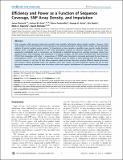Efficiency and Power as a Function of Sequence Coverage, SNP Array Density, and Imputation
Author(s)
Flannick, Jason; Korn, Joshua M.; Fontanillas, Pierre; Grant, George B.; Depristo, Mark A.; Altshuler, David; Banks, Eric, 1976-; ... Show more Show less
DownloadFlannick-2012-Efficiency and power.pdf (1.078Mb)
PUBLISHER_POLICY
Publisher Policy
Article is made available in accordance with the publisher's policy and may be subject to US copyright law. Please refer to the publisher's site for terms of use.
Terms of use
Metadata
Show full item recordAbstract
High coverage whole genome sequencing provides near complete information about genetic variation. However, other technologies can be more efficient in some settings by (a) reducing redundant coverage within samples and (b) exploiting patterns of genetic variation across samples. To characterize as many samples as possible, many genetic studies therefore employ lower coverage sequencing or SNP array genotyping coupled to statistical imputation. To compare these approaches individually and in conjunction, we developed a statistical framework to estimate genotypes jointly from sequence reads, array intensities, and imputation. In European samples, we find similar sensitivity (89%) and specificity (99.6%) from imputation with either 1× sequencing or 1 M SNP arrays. Sensitivity is increased, particularly for low-frequency polymorphisms (MAF <5%), when low coverage sequence reads are added to dense genome-wide SNP arrays — the converse, however, is not true. At sites where sequence reads and array intensities produce different sample genotypes, joint analysis reduces genotype errors and identifies novel error modes. Our joint framework informs the use of next-generation sequencing in genome wide association studies and supports development of improved methods for genotype calling.
Date issued
2012-07Department
Harvard University--MIT Division of Health Sciences and Technology; Massachusetts Institute of Technology. Department of BiologyJournal
PLoS Computational Biology
Publisher
Public Library of Science
Citation
Flannick, Jason et al. “Efficiency and Power as a Function of Sequence Coverage, SNP Array Density, and Imputation.” Ed. Jan Korbel. PLoS Computational Biology 8.7 (2012): e1002604.
Version: Final published version
ISSN
1553-734X
1553-7358